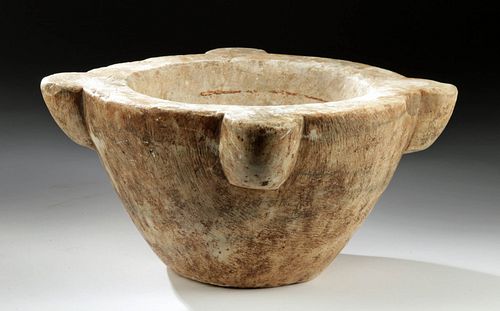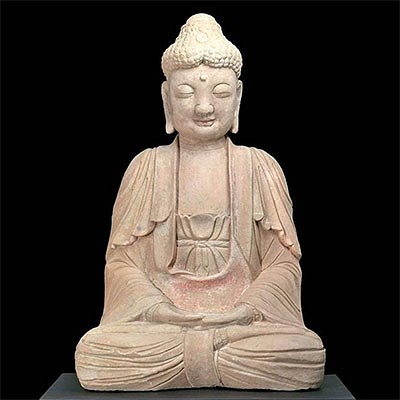Egyptian Alabaster Mortar w/ Four Handles
Lot 10b
About Seller
Artemis Gallery
686 S Taylor Ave, Ste 106
Louisville, CO 80027
United States
Selling antiquities, ancient and ethnographic art online since 1993, Artemis Gallery specializes in Classical Antiquities (Egyptian, Greek, Roman, Near Eastern), Asian, Pre-Columbian, African / Tribal / Oceanographic art. Our extensive inventory includes pottery, stone, metal, wood, glass and textil...Read more
Categories
Estimate:
$3,400 - $5,100
Absentee vs Live bid
Two ways to bid:
- Leave a max absentee bid and the platform will bid on your behalf up to your maximum bid during the live auction.
- Bid live during the auction and your bids will be submitted real-time to the auctioneer.
Bid Increments
| Price | Bid Increment |
|---|---|
| $0 | $25 |
| $300 | $50 |
| $1,000 | $100 |
| $2,000 | $250 |
| $5,000 | $500 |
| $10,000 | $1,000 |
| $20,000 | $2,500 |
| $50,000 | $5,000 |
| $100,000 | $10,000 |
| $200,000 | $20,000 |
About Auction
By Artemis Gallery
Feb 18, 2021
Set Reminder
2021-02-18 10:00:00
2021-02-18 10:00:00
America/New_York
Bidsquare
Bidsquare : Exceptional Antiquities, Asian, Ethnographic
https://www.bidsquare.com/auctions/artemis-gallery/exceptional-antiquities-asian-ethnographic-6373
Museum-worthy examples of Egyptian, Greek, Roman, Etruscan, Near Eastern, Far East / Asian, Pre-Columbian, African / Tribal, Oceanic, Native American, Spanish Colonial, Russian, Fossils, Ancient Jewelry, Fine Art, so much more! Artemis Gallery info@artemisgallery.com
Museum-worthy examples of Egyptian, Greek, Roman, Etruscan, Near Eastern, Far East / Asian, Pre-Columbian, African / Tribal, Oceanic, Native American, Spanish Colonial, Russian, Fossils, Ancient Jewelry, Fine Art, so much more! Artemis Gallery info@artemisgallery.com
- Lot Description
Egypt, Late Dynastic to Ptolemaic Period, ca. 664 to 30 BCE. A finely preserved mortar of a sizable form, hand-carved from honey-yellow alabaster. The vessel is defined by a flat circular base, a tall hemispherical body with a deep basin, a flat shoulder, and four protruding handles spaced equidistantly around the circumference. The surfaces of the shoulder and top half of the basin walls are incredibly smooth to the touch, and the lower half of the basin exhibits a coarse texture perhaps formed from centuries of gradual degradation. In ancient Egypt, mortars and pestles were used for a variety of tasks, including dehusking hulled wheat, making pastes for construction, grinding ingredients for medicinal remedies, and pulverizing other foodstuffs, though they were perhaps used as funerary offering bowls for its deceased owner. Smaller mortars have been found in the domestic housing at workmen's villages excavated at Deir el-Medina and Amarna. Size: 15.1" W x 6.8" H (38.4 cm x 17.3 cm).
A stylistically similar example, of a much smaller size and carved from banded alabaster, hammered for $8,750 at Christie's, New York "Antiquities" auction (sale 2605, December 5, 2012, lot 135).
Provenance: private J.H. collection, Beaverton, Oregon, USA, acquired before 2017; ex-Relics of the Nile, Lexington, Kentucky, USA, before 2011
All items legal to buy/sell under U.S. Statute covering cultural patrimony Code 2600, CHAPTER 14, and are guaranteed to be as described or your money back.
A Certificate of Authenticity will accompany all winning bids.
We ship worldwide and handle all shipping in-house for your convenience.
#149586Original pestle missing. Minor chips and abrasions to basin, handles, body, and base, with light encrustations, and light pitting in some areas, otherwise intact and very good. Nice earthen deposits throughout, and smooth patina along shoulders, body, and top half of basin interior.Condition
- Shipping Info
-
All shipping is handled in-house for your convenience. Your invoice from Artemis Gallery will include shipping calculation instructions. If in doubt, please inquire BEFORE bidding for estimated shipping costs for individual items.
-
- Buyer's Premium



 EUR
EUR CAD
CAD AUD
AUD GBP
GBP MXN
MXN HKD
HKD CNY
CNY MYR
MYR SEK
SEK SGD
SGD CHF
CHF THB
THB
















